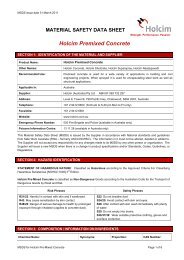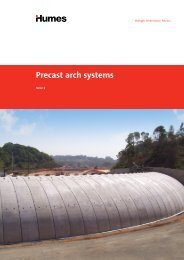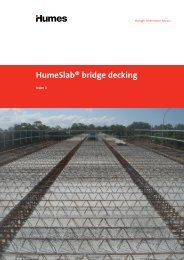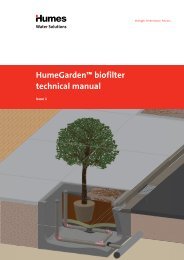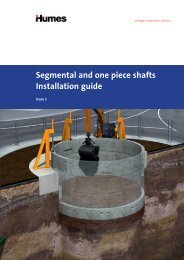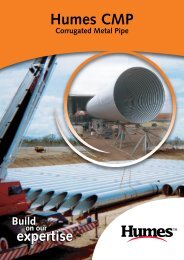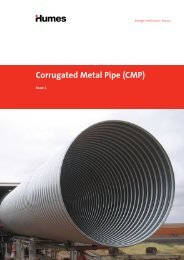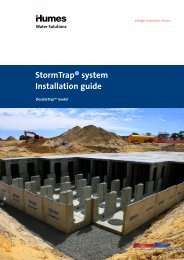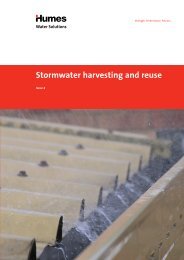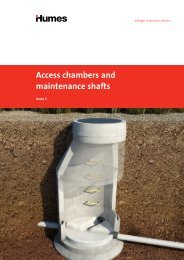Plastiline™ - Humes
Plastiline™ - Humes
Plastiline™ - Humes
You also want an ePaper? Increase the reach of your titles
YUMPU automatically turns print PDFs into web optimized ePapers that Google loves.
11 Testing<br />
11.1 Prior to conducting tests listed in this section, careful<br />
inspection shall be made for visible damage and faulty<br />
welding. After joint welding of blankets in pipelines and<br />
structures, all welds shall be subjected to the tests<br />
specified in this section.<br />
11.2 Particular attention must be given to weld beads on<br />
both sides of weld strips (see illustration). After welding,<br />
beads should be visible on both sides of the weld strip.<br />
The weld must be checked by probing the fillet area with a<br />
well worn (i.e. no sharp edges) screwdriver blade. At any<br />
place where the probe indicates a weak weld, or enters<br />
more than 3mm, a reweld shall be made in<br />
accordance with the procedure specified in Clauses 12.6<br />
and 12.7 of this specification. If overheating has occurred<br />
during welding the evidence is charring at the edge of the<br />
strip. All charred sections must be replaced.<br />
11.3 If required by the client, the lined surface shall be<br />
100% spark tested using an approved spark tester and<br />
brush with a potential of at least 10,000 volts. Two<br />
alternative methods of positively testing joints and<br />
patches are the vacuum box method for flat areas such as<br />
tanks, and the pipe weld tester for pipelines. Both the<br />
vacuum box and pipe weld tester must be of an approved<br />
design. If the vacuum box is used as a means of testing,<br />
<strong>Humes</strong> should be consulted as special design characteristics<br />
assist in testing by this method.<br />
Defective areas found by these tests must be repaired as<br />
per Section 12 and subsequently retested.<br />
11.4 Where required by the client, a pull test can be<br />
performed to check that proper embedment of keys has<br />
been achieved. A direct pull is applied normal to the<br />
concrete surface, on a cut section of the embedded sheet<br />
containing a single embedded key 100mm to 200mm long.<br />
The concrete should be fully cured and the key shall<br />
withstand the specified pull of 14 N/mm without rupture of<br />
the concrete or the key, or withdrawal of the key from<br />
the concrete. Strictly the test should be made at a<br />
temperature between 10 O C and 27 O C and at least 14 days<br />
after embedment. Refer to <strong>Humes</strong> if full details are<br />
required.<br />
11.5 Where large areas of lining are involved, testing must<br />
be carried out progressively as the work proceeds to avoid<br />
accumulation of defects from faulty workmanship which<br />
could have been detected and corrected at an early stage.<br />
Spark testing may not detect faults in welds or where<br />
sheets overlap, and must be supplemented by the other<br />
procedures described above in order to ensure sound<br />
workmanship in these areas.<br />
Plastiline spark testing.<br />
17



